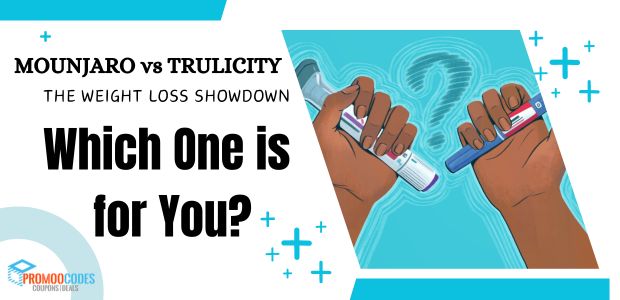
Which one is better for weight loss? In this article, you will get to know about the insights of type-2 drugs Mounjaro and Trulicity. The comparison between Mounjaro vs Trulicity will help you understand which option is best suitable for you. Mounjaro and Trulicity are drugs used for treating type-2 diabetes and are prescribed off-label for the use of weight loss.
Manufactured by Eli Lilly, they both include a weekly injection and target the GLP-1 receptor, which curbs hunger and makes you feel fuller and faster for a long time.
So what makes the difference? Trulicity vs Mounjaro Weight loss has proven much more effective in promoting weight loss. While they help in managing diabetes. However, there are some notable differences between the two medications. The patients should considered before deciding which one to take.
What is Mounjaro?

Mounjaro is an injectable prescription medicine used with diet and exercise to reduce and improve the blood sugar level(Glucose) in adults or treat children under 18 years of age. Mounjaro can also be used to treat people who have pancreatitis. It is an approved medication by the FDA (U.S. Food and Drug Administration). It is manufactured by Eli Lilly and Co.
Mounjaro imitates 2 types of Incretin hormones produced by the human body. It is classed as a GIP (glucose-dependent insulinotropic polypeptide) and GLP-1(glucagon-like peptide-1) receptor agonist.
GIP decreases the intake of food and increases energy expenditure which causes weight loss. When taken with a GLP-1, it results in greater positive effects on blood glucose and body weight.
What is Trulicity?

Trulicity is FDA(U.S. Food and Drug Administration) Approved in 2014 as a treatment for type-2 diabetes. It was later approved in February 2020 to reduce the risk of cardiovascular complications like heart attacks in adults with type 2 diabetes. It is not approved by the FDA for weight loss.
Currently, the GlP-1 agonists approved for weight loss and obesity are the higher versions of Wegovy and Saxenda.
If someone has type 2 diabetes, they may not be able to produce enough insulin, or they may have become resistant to insulin.
If this happens, you will absorb less sugar from your blood which will result in your blood glucose level remaining too high.
What are the dosages for both Mounjaro and Trulicity?

Mounjaro is available in injection form, in the dosage of 2.5 mg/0.5 ml, 5mg/0.5 ml, 7.5 mg/0.5 ml, 10 mg/0.5 ml, 12.5 mg/0.5 ml, or 15 mg/0.5 ml single-dose pens. Whereas Trulicity is available in 0.75 mg/0.5 ml solution in a single-dose pen, and 1.5 mg/0.5 ml solution in a single-dose pen in an injection form.
Mounjaro is injected under the stomach in the abdomen, thigh, or upper arm once a week. Use it with or without food. If you miss a dose, take the missed dose as soon as possible within 96 hours after you missed any. If it takes more than 4 days, skip the missed dose and take the next dose at the regular scheduled time though Trulicity is used in the same as Mounjaro in the abdomen, thigh, or upper arm once a week at any time of the day. 0.75 mg should be used once weekly. The dose can be increased to 1.5 mg once.
Always speak with a healthcare professional about any changes in your dose. So, that they can monitor and evaluate your condition.
How are Mounjaro and Trulicity different?

Mounjaro targets the GLP-1 and GLP receptors, while Trulicity targets only GLP-1. The GIP is a hormone that helps with food digestion. It works with GLP-1 to help promote insulation secretion, regulate blood glucose levels, and help with fat metabolism.
It aids the slow down in digestion of the food, which might help you feel fuller and more satisfied for a longer duration. Studies say that GLP-1 and GIP work together in the body to help monitor insulin levels, which could make Mounjaro a more effective treatment for obesity than Trulicity.
Mounjaro vs Trulicity: How to take the insulin?
While taking Mounjaro keep this in mind:
- Read the instruction card when using Mounjaro
- Use Mounjaro exactly as your healthcare provider says.
- Mounjaro is injected under the skin of your stomach, thigh, or upper arm
- Take Mounjaro 1 time each week, at any time
- Do not mix insulin of Mounjaro and insulin in the same body area, but not right next to each other
- Do not mix insulin and Mounjaro together
- Apply injection on the same area of the body, not right next to each other
- Do not use the same site of injection each time
- If taken too much, then call your healthcare provider or seek medical advice promptly
While taking Trulicity keep this in mind:
- Use Trulicity exactly as your physicians say
- Do not share your Trulicity pen, or needles with someone else
- Do not give Trulicity to other people
- If taken too much, contact your healthcare provider
Comparing Mounjaro vs Trulicity for weight loss

In recent clinical trials, participants who took Mounjaro reported a mean percentage of weight change of -15% at week 72. The results say that those on Mounjaro lost between 25 to 50 lbs after 72 weeks.
These results supported an accurately significant weight loss for Eli Lilly, who continued with the next clinical trials of Mounjaro as a weight loss treatment.
Whereas, Trulicity clinical trials revealed that some patients did lose weight, with an average weight loss of 8.4 lb for 3.0 mg.
However, the results are not exact, while the study claims that with 1.5 mg loss of an average of 6.6 lb occurred, and those at 4.5 mg lost an average of -10.1 lb. It was reported to be sustained at 52 weeks
Although both give promising results as weight loss drugs, Mounjaro shows precisely significant weight loss in clinical trials. Both drugs are FDA approved but they are yet to be approved for as weight loss aid.
comparison of Mounjaro vs Trulicity Cost
Mounjaro costs approximately $1,023.04 per fill without insurance, while Trulicity costs around $930.88. Trulicity is a slightly older drug while Mounjaro has only recently been added to the market as a type-2 diabetes treatment, which is why it is at a higher cost. However, you can make it cheaper by using the Mounjaro Coupon Code available exclusively.
With Mounjaro-covered insurance, four pens can cost up to $25 a month with prescriptions of up to 3 months. Whereas Trulicity insurance providers tend to cost patients between $0-$30 per month, making it cheaper for the weight loss drugs.
Mounjaro vs Trulicity Side Effects

The common side effects of Mounjaro are
- Nausea, vomiting
- Gastrointestinal- diarrhea
Some more serious side effects include:
- Possible thyroid tumors
- Inflammation of the pancreas (pancreatitis)- symptoms include severe pain in your stomach area that will not go away, with or without vomiting.
- Low blood sugar level- your risk for low blood sugar may be increased if you use Mounjaro with another diabetes medication such as insulin
- Serious allergic reactions
- Kidney problems
- Severe stomach problems
- Vision changes
- Gallbladder problems
The common side effects of Trulicity are
- Injection-site reactions like swelling, pain, or itching
- Nausea, vomiting
- Gastrointestinal side effects
- Reduced appetite
Some more serious effects include:
- Severe allergic reactions to the medication
- Thyroid tumors
- Inflammation of the pancreas
- Kidney problems including kidney failure
- your blood sugar falling too low
- Severe stomach problems
- Change in the visions
These are not all the Mounjaro vs Trulicity Side Effects. You can find more details in the details that come with the medication.
Contraindications for Mounjaro vs Trulicity Weight loss medication
You should not use Mounjaro if you:
- Are allergic to the active ingredient tirzepatide
- Are allergic to any of the other ingredients that are available in Mounjaro
consult your doctor before using it if you:
- any medications that could interact with Mounjaro
- Have or have had problems with the pancreas or kidneys
- Have a history of diabetic retinopathy
- If you are pregnant or planning to be pregnant
- If you are breastfeeding or planning to
You should not use Trulicity if you:
- Are allergic to the active ingredient dulaglutide
- Is allergic to any other ingredients available in Trulicity
- Have type 1 diabetes
- Have diabetic Ketoacidosis
- Have the type of thyroid cancer called medullary thyroid carcinoma
- Are under 18 years of age
consult your doctor before using it:
- taking any other medications that could interact with Trulicity
- Has any problem with your pancreas
- Has any problem with the liver
- Has any problem with your kidneys
- Have severe stomach or intestinal problems
- Are pregnant or planning to be
- Are breastfeeding or are planning to
Mounjaro and Trulicity Drug Interaction
Mounjaro can also interact with other medications. These include:
- Insulin secretagogue
- Oral medications
- Orally administered hormonal contraceptives
Trulicity can also contract with other medications. These include:
- Any diabetes medications
- Estrogens
- Oral contraceptives
- Nicotinic acid
- Calcium channel-blocking drugs
Mounjaro and Trulicity can interact with other medications. These medications work and can make side effects more likely. Before using any drug consult your physicians.
Mounjaro vs Trulicity: How do they work?

Weight-loss drugs imitate the actions of hormones in the gut that are normally released after you eat the food. These hormones manage your blood sugar levels by slowing down the speed at which your body releases sugar. It then increases the rate at which your pancreas produces insulin.
Both Mounjaro and Trulicity do this to target the body’s GLP-1. Mounjaro additionally mimics the effect of the hormone GLP.
Mounjaro has a dual effect compared to Trulicity. They target two of the body’s insulin-controlling hormones.
This is effective as it mimics two of the body’s naturally occurring glucose mechanisms. A study in cardiovascular diabetology shows that 38% of individuals using Tirzepatide reported blood sugar levels in nondiabetic ranges and significant weight loss.
It’s the dual effect of GLP-1 and GIP that sets Mounjaro apart from Trulicity. Instead of simply helping your body increase its insulin production, Mounjaro increases a patient’s sensitivity to insulin. It will help patients achieve a healthy AC1 reading faster. It will also increase the rate of weight loss.
Conclusion:-

Mounjaro is a medication that works for dual mechanisms of GLP-1 and GIP to help manage blood sugar levels and promote weight loss.
Clinical studies claim that it can be more effective than Trulicity in achieving these goals.
However, it’s important to remember that every person’s medical needs and problems are different, and should make sure to check out which is better for them. As it may not work for one person but maybe for another one.
It’s important to discuss or consult with your doctor to determine the best treatment for your needs.
They may provide you with the best benefits, make you understand the potential risks of Mounjaro, and guide you in making a good decision about the treatment options.
